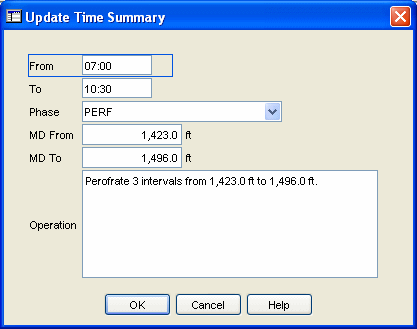General Section
Perforation Report
The General section of the Perforation report is used to gather information about perforations performed on the wellbore in the following sections:
Update Time Summary Button
The Update Time Summary button
allows users to push data entered in specific reports directly into a
new row in the Time Summary spreadsheet. This button is configured in
the Layout Manager of the EDM Administration Utility. This button reduces
data entry time and duplication.
This feature is available
in the following areas:
Classic Entry
Form: Casing, Cementing, Perforation, Stimulations and Wellbore
Equipment,
When the Update
Time Summary button is selected in the OpenWells® application the
Update Time Summary dialog appears.
From this dialog the user
can verify the data is correct, edit if necessary or click OK
to push the data to the Time Summary spreadsheet.
The following sample shows
data pushed from a Perforation report to the Time Summary spreadsheet.


General
Perforated String
The Perforated String picklist lists all casings, liners and assembly strings that have been recorded for the wellbore. Select the specific casing, liner, or assembly string which was perforated.
Note: Verify that the correct perforated string has been selected from the picklist. The item selected for this field will affect the Schematic drawn in the PROFILE™application.
Contractor
Use the picklist to select a Contractor. If the Contractor performing the perforation job is not in the picklist, enter the company name in the field or add it to the picklist using the Picklist Editor.
Conveyed Method
Select how the perforation guns were conveyed down hole from the options available in the picklist.
Initial Conditions
The following fields are automatically calculated by OpenWells® software:
Fluid Head
Fluid Head = TVD Reservoir - TVD Fluid Top
Hydrostatic Pressure
Hydrostatic Pressure is calculated as a function of the Fluid Density and TVD Reservoir (Surface Pressure is also added to display effective Hydrostatic Press (Hydrostatic Pressure) at TVD Reservoir).
Pressure Difference
Pressure Difference = Hydrostatic Pressure - Estimate Reservoir Pressure
Underbalanced check box
The Underbalanced check box is automatically checked if the Pressure Difference field contains a negative value. This check box cannot be modified.
Condition
The Condition field is based on the calculated results found in the Pressure Difference field. There are three possible entries:
-
-
Over Balanced (positive number in Pressure Difference field) — The Condition is Over Balanced if the hydrostatic pressure exerted by the wellbore fluid inside the casing or liner is greater than the reservoir pressure. Once the perforation is made, there will be a tendency for the wellbore fluid to flow into the reservoir formation.
-
-
Summary
MD Top
The Measured Depth (MD) Top of the shallowest shot that is entered in the Intervals spreadsheet.
MD Base
The Measured Depth (MD) Base of the deepest shot that is entered in the Intervals spreadsheet.
Net Perforation Interval
The Net Perforation Interval is calculated as the sum of the difference between the MD Base less the MD Top for all intervals entered in the Intervals spreadsheet.
Perforation Length Gross
The Gross Perforation Length is calculated as the distance between the uppermost and lowermost shots entered in the Intervals spreadsheet for the perforation operation.
No. of Intervals
The Number of Intervals is calculated from the shot intervals entered in the Intervals spreadsheet.
Centralization Method
Enter the centralization method used for the perforation.
Total Shots
The Total Shots field is the sum of the following calculation for all rows in the Intervals spreadsheet.
Total Shots = {SP/ (shot/ft) x [TS-BS (length)]} + Additional Shot - Misfires
Average Shot Density
The Average Shot Density is calculated from the values in the Intervals spreadsheet.
Average Shot Density = Total Shots / Net Perforation Interval
Fluid Loss
Enter the amount of fluid loss after pills have been spotted and the perforation gun fired.
Pills Spotted
If fluid pills were used during the perforation, enter the type in the Pills Spotted Type field and the amount used in the Pills Spotted Volume.
Reference Log
Select the date and an associated reference log from the picklist for the perforation job. This list is populated from Log Suites (runs) created in the Logging report.
General Comments
Enter any additional comments regarding the perforation in this section.
Related Topics
About the Perforation Report

